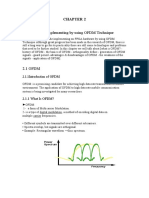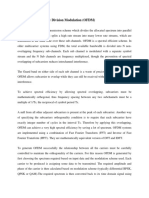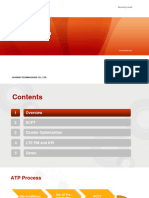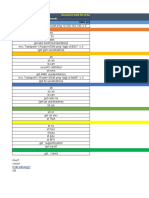Introduction To OFDM
Uploaded by
Vimal RajIntroduction To OFDM
Uploaded by
Vimal RajIntroduction to OFDM - Orthogonal Frequency
Division Multiplexing
Orthogonal Frequency Division Multiplexing (OFDM) is a digital multi-carrier modulation
scheme that extends the concept of single subcarrier modulation by using multiple subcarriers
within the same single channel. Rather than transmit a high-rate stream of data with a single
subcarrier, OFDM makes use of a large number of closely spaced orthogonal subcarriers that
are transmitted in parallel. Each subcarrier is modulated with a conventional digital
modulation scheme (such as QPSK, 16QAM, etc.) at low symbol rate. However, the
combination of many subcarriers enables data rates similar to conventional single-carrier
modulation schemes within equivalent bandwidths.
OFDM is based on the well-known technique of Frequency Division Multiplexing (FDM). In FDM
different streams of information are mapped onto separate parallel frequency channels. Each
FDM channel is separated from the others by a frequency guard band to reduce interference
between adjacent channels.
The OFDM scheme differs from traditional FDM in the following interrelated ways:
1. Multiple carriers (called subcarriers) carry the information stream,
2. The subcarriers are orthogonal to each other, and
3. A guard interval is added to each symbol to minimize the channel delay spread and
intersymbol interference.
(Orthogonal Frequency Division Multiplexing) A digital transmission technique
that uses a large number of carriers spaced apart at slightly different
frequencies. First promoted in the early 1990s for wireless LANs, OFDM is
used in many wireless applications including Wi-Fi, WiMAX, LTE, ultra-
wideband (UMB), as well as digital radio and TV broadcasting in Europe and
Japan. OFDM is also used in land-based ADSL Internet service (see DSL).
OFDM Uses Subcarriers
Although frequency division multiplexing (FDM) by itself implies multiple data
streams, OFDM carries only one data stream broken up into multiple signals.
Hundreds of carriers are used; each one a "subcarrier" for a single data
channel.
OFDM subcarriers can be modulated by any method, although QAM and
QPSK are typically used (see QAM and PSK). Coded OFDM (COFDM) adds
forward error correction. See OFDMA, carrier, bandwidth, CCK/OFDM and 8-
VSB.
What is OFDM
1.
Orthogonal frequency-division multiplexing (OFDM) is a very popular modulation scheme for wideband
digital communications used in applications such as wireless networking and digital television. It is a
frequency-division multiplexing (FDM) scheme in which a large number of closely-spaced orthogonal
subcarriers are modulated with the transmit data using conventional modulation schemes such as QAM
or PSK. Learn more in: Power Issues and Energy Scavenging in Mobile Wireless Ad-hoc and Sensor
Networks
2.
It is a digital modulation technique in which a single data stream is split into multiple parallel streams and
transmitted over narrow overlapping subcarriers. Learn more in: An Introduction to LiFi and Review of
Prototypes Designed on FPGA and Other Hardware
3.
Orthogonal Frequency Division Multiplexing is a modulation technique for transmission over a frequency-
selective channel. OFDM divides the channel into multiple orthogonal frequencies, and each frequency
will use a subcarrier where data streams are transmitted. Because the concurrent subcarriers carry
different data streams, OFDM allows high spectral efficiency. Learn more in: Advances of Radio Interface
in WCDMA Systems
4.
Orthogonal frequency division multiplexing is a technique that splits a wide frequency band into a number
of narrow frequency bands and inverse multiplexes data across the subchannels. Both 802.11a and the
forthcoming 802.11g standards are based on OFDM. Learn more in: Security and Privacy Approaches for
Wireless Local and Metropolitan Area Networks (LANs & MANs)
5.
A method of encoding digital data on multiple carrier frequencies. Learn more in: Visible Light
Communication Numerous Applications
6.
Orthogonal frequency division multiplexing. Learn more in: Mobile Network Architecture: 3GPP
Generations (UMTS, LTE, and Pre-5G)
7.
Orthogonal Frequency Division Multiplexing (OFDM / OFDMA) technology. This is a technique for
transmitting large amounts of digital data over a radio waves. OFDM works by splitting the radio signal
into multiple smaller sub-signals that are then transmitted simultaneously at different frequencies to the
receiver. Learn more in: The Diffusion of WiMax Technology: Hurdles and Opportunities
8.
A method of encoding digital data on multiple carrier frequencies. Learn more in: Visible Light
Communication Numerous Applications
9.
Orthogonal Frequency-Division Multiplexing. Learn more in: Mobile Telecom System Architectures—IMS
an Evolution Path Towards IP Convergence
Key features of OFDM
Multiple carriers (called subcarriers) carry the information stream.
The subcarriers are orthogonal to each other.
A guard interval is added to each symbol to minimize the channel delay spread
and intersymbol interference
Existing system:
These techniques are divided into two groups. These are signal scrambling techniques and signal
distortion techniques. The signal scrambling techniques are:
Signal Scrambling Techniques
(i)Block Coding
(ii) Selective Mapping Method(SLM)
(iii) Partial Transmit Sequence(PTS)
Disadvantages:
System suffers from high PAPR and ISI.
ICI occurs due to loss of Orthogonality
Requires time and frequency synchronization to get a low BER
The 5G mobile network promises to be faster and smarter and has lower latency and higher efficiency,
lower bandwidth issues compared to 4G.
You might also like
- Orthogonal Frequency Division Multiplexing OfdmNo ratings yetOrthogonal Frequency Division Multiplexing Ofdm11 pages
- University of Kufa: Department of Electrical EngineeringNo ratings yetUniversity of Kufa: Department of Electrical Engineering19 pages
- A Review On OFDM: Concept, Scope & Its Applications: Manushree Bhardwaj, Arun Gangwar, Devendra SoniNo ratings yetA Review On OFDM: Concept, Scope & Its Applications: Manushree Bhardwaj, Arun Gangwar, Devendra Soni5 pages
- Understanding The Use of Ofdm in Ieee 802.16 (Wimax) : Roberto SacchiNo ratings yetUnderstanding The Use of Ofdm in Ieee 802.16 (Wimax) : Roberto Sacchi8 pages
- Orthogonal Frequency Division Multiplexing Presented Gaurav: By: DubeyNo ratings yetOrthogonal Frequency Division Multiplexing Presented Gaurav: By: Dubey22 pages
- Ofdm (Orthogonal Frequency Division Multiplexing)No ratings yetOfdm (Orthogonal Frequency Division Multiplexing)20 pages
- MIMO-OFDM High Data Rate Wireless System Using V-BLAST MethodNo ratings yetMIMO-OFDM High Data Rate Wireless System Using V-BLAST Method9 pages
- Orthogonal Frequency Division MultiplexingNo ratings yetOrthogonal Frequency Division Multiplexing19 pages
- OFDM: Orthogonal Frequency-Division Multiplexing By: Tushar SaxenaNo ratings yetOFDM: Orthogonal Frequency-Division Multiplexing By: Tushar Saxena3 pages
- Orthogonal Frequency Division Multiplexing: Presented By-Ashish Bhalla 1807225No ratings yetOrthogonal Frequency Division Multiplexing: Presented By-Ashish Bhalla 180722519 pages
- Wireless Communications: Orthogonal Frequency-Division Multiplexing (OFDM)No ratings yetWireless Communications: Orthogonal Frequency-Division Multiplexing (OFDM)16 pages
- Performance Evaluation of OFDM System With Rayleigh, Rician and AWGN Channelst Report Manmeet KhuranaNo ratings yetPerformance Evaluation of OFDM System With Rayleigh, Rician and AWGN Channelst Report Manmeet Khurana7 pages
- Orthogonal Frequency Division MultiplexingNo ratings yetOrthogonal Frequency Division Multiplexing15 pages
- Orthogonal Frequency Division MultiplexingNo ratings yetOrthogonal Frequency Division Multiplexing15 pages
- Orthogonal Frequency-Division Multiplexing (OFDM) : FAQ TutorialNo ratings yetOrthogonal Frequency-Division Multiplexing (OFDM) : FAQ Tutorial11 pages
- Orthogonal Frequency Division Modulation (OFDM)No ratings yetOrthogonal Frequency Division Modulation (OFDM)2 pages
- OFDMA and MIMO Notes: EE 442 - Spring SemesterNo ratings yetOFDMA and MIMO Notes: EE 442 - Spring Semester53 pages
- Introduction To OFDM - Orthogonal Frequency Division MultiplexingNo ratings yetIntroduction To OFDM - Orthogonal Frequency Division Multiplexing9 pages
- Orthogonal Frequency Division Multiplexing 1.1 Overview: (OFDM)No ratings yetOrthogonal Frequency Division Multiplexing 1.1 Overview: (OFDM)9 pages
- Physical Media Dependent Sublayer With Effective Randomization For Welch Spectrum Shaping of Fixed Broadband Wireless AcessNo ratings yetPhysical Media Dependent Sublayer With Effective Randomization For Welch Spectrum Shaping of Fixed Broadband Wireless Acess7 pages
- All CHAPTER - Mod - Phase2.Doc (Modified)No ratings yetAll CHAPTER - Mod - Phase2.Doc (Modified)30 pages
- VHDL Design and Synthesis of An Orthogonal Frequency Division Multiplexing SystemNo ratings yetVHDL Design and Synthesis of An Orthogonal Frequency Division Multiplexing System3 pages
- How, What Is Orthogonal Frequency-Division Multiplexing (OFDM) - 123No ratings yetHow, What Is Orthogonal Frequency-Division Multiplexing (OFDM) - 1237 pages
- Lecture 3 - Orthogonal Frequency-Division Multiplexing (OFDM)No ratings yetLecture 3 - Orthogonal Frequency-Division Multiplexing (OFDM)48 pages
- Orthogonal Frequency Division MultiplexingNo ratings yetOrthogonal Frequency Division Multiplexing49 pages
- Raana Semicondutors PVT LTD: ARM 7-LPC2148 Development BoardNo ratings yetRaana Semicondutors PVT LTD: ARM 7-LPC2148 Development Board107 pages
- 50992227FMJN - Digital Principles & System Design - Solution ManualNo ratings yet50992227FMJN - Digital Principles & System Design - Solution Manual31 pages
- Digital Signal Processing by Ramesh Babu PDFNo ratings yetDigital Signal Processing by Ramesh Babu PDF303 pages
- Anna University: Madras Institute of Technology CampusNo ratings yetAnna University: Madras Institute of Technology Campus4 pages
- Introduction To VLSI Technology: Abhijeet KumarNo ratings yetIntroduction To VLSI Technology: Abhijeet Kumar32 pages
- Programming (C Programming) Internship in Chennai at Logitech - InternshalaNo ratings yetProgramming (C Programming) Internship in Chennai at Logitech - Internshala2 pages
- A Study On The Different Image Segmentation Technique: ISO 9001:2008 CertifiedNo ratings yetA Study On The Different Image Segmentation Technique: ISO 9001:2008 Certified6 pages
- Using Signaltap Ii Embedded Logic Analyzers in Sopc Builder SystemsNo ratings yetUsing Signaltap Ii Embedded Logic Analyzers in Sopc Builder Systems21 pages
- Huawei Wi-Fi 6 AP Tolly Test Report (AP7060DN AirEngine 5760-10) PDFNo ratings yetHuawei Wi-Fi 6 AP Tolly Test Report (AP7060DN AirEngine 5760-10) PDF11 pages
- OAM Ping 2G Part: Document Valid For All Baseband TypesNo ratings yetOAM Ping 2G Part: Document Valid For All Baseband Types4 pages
- Airtel Mobile Plans - Prepaid and Postpaid ConnectionNo ratings yetAirtel Mobile Plans - Prepaid and Postpaid Connection2 pages
- Wi-Fi Alliance Wi-Fi Security Roadmap and Wpa3 ™ UpdatesNo ratings yetWi-Fi Alliance Wi-Fi Security Roadmap and Wpa3 ™ Updates38 pages
- 5G (From "5th Generation") Is The Latest Generation of Cellular MobileNo ratings yet5G (From "5th Generation") Is The Latest Generation of Cellular Mobile13 pages
- Nokia Qualcomm Enhanced Cell Fach White PaperNo ratings yetNokia Qualcomm Enhanced Cell Fach White Paper16 pages
- Mobile Application Development: Practical 2No ratings yetMobile Application Development: Practical 27 pages
- Concise Guide to OTN optical transport networksFrom EverandConcise Guide to OTN optical transport networks
- University of Kufa: Department of Electrical EngineeringUniversity of Kufa: Department of Electrical Engineering
- A Review On OFDM: Concept, Scope & Its Applications: Manushree Bhardwaj, Arun Gangwar, Devendra SoniA Review On OFDM: Concept, Scope & Its Applications: Manushree Bhardwaj, Arun Gangwar, Devendra Soni
- Understanding The Use of Ofdm in Ieee 802.16 (Wimax) : Roberto SacchiUnderstanding The Use of Ofdm in Ieee 802.16 (Wimax) : Roberto Sacchi
- Orthogonal Frequency Division Multiplexing Presented Gaurav: By: DubeyOrthogonal Frequency Division Multiplexing Presented Gaurav: By: Dubey
- MIMO-OFDM High Data Rate Wireless System Using V-BLAST MethodMIMO-OFDM High Data Rate Wireless System Using V-BLAST Method
- OFDM: Orthogonal Frequency-Division Multiplexing By: Tushar SaxenaOFDM: Orthogonal Frequency-Division Multiplexing By: Tushar Saxena
- Orthogonal Frequency Division Multiplexing: Presented By-Ashish Bhalla 1807225Orthogonal Frequency Division Multiplexing: Presented By-Ashish Bhalla 1807225
- Wireless Communications: Orthogonal Frequency-Division Multiplexing (OFDM)Wireless Communications: Orthogonal Frequency-Division Multiplexing (OFDM)
- Performance Evaluation of OFDM System With Rayleigh, Rician and AWGN Channelst Report Manmeet KhuranaPerformance Evaluation of OFDM System With Rayleigh, Rician and AWGN Channelst Report Manmeet Khurana
- Orthogonal Frequency-Division Multiplexing (OFDM) : FAQ TutorialOrthogonal Frequency-Division Multiplexing (OFDM) : FAQ Tutorial
- Introduction To OFDM - Orthogonal Frequency Division MultiplexingIntroduction To OFDM - Orthogonal Frequency Division Multiplexing
- Orthogonal Frequency Division Multiplexing 1.1 Overview: (OFDM)Orthogonal Frequency Division Multiplexing 1.1 Overview: (OFDM)
- Physical Media Dependent Sublayer With Effective Randomization For Welch Spectrum Shaping of Fixed Broadband Wireless AcessPhysical Media Dependent Sublayer With Effective Randomization For Welch Spectrum Shaping of Fixed Broadband Wireless Acess
- VHDL Design and Synthesis of An Orthogonal Frequency Division Multiplexing SystemVHDL Design and Synthesis of An Orthogonal Frequency Division Multiplexing System
- How, What Is Orthogonal Frequency-Division Multiplexing (OFDM) - 123How, What Is Orthogonal Frequency-Division Multiplexing (OFDM) - 123
- Lecture 3 - Orthogonal Frequency-Division Multiplexing (OFDM)Lecture 3 - Orthogonal Frequency-Division Multiplexing (OFDM)
- Raana Semicondutors PVT LTD: ARM 7-LPC2148 Development BoardRaana Semicondutors PVT LTD: ARM 7-LPC2148 Development Board
- 50992227FMJN - Digital Principles & System Design - Solution Manual50992227FMJN - Digital Principles & System Design - Solution Manual
- Anna University: Madras Institute of Technology CampusAnna University: Madras Institute of Technology Campus
- Programming (C Programming) Internship in Chennai at Logitech - InternshalaProgramming (C Programming) Internship in Chennai at Logitech - Internshala
- A Study On The Different Image Segmentation Technique: ISO 9001:2008 CertifiedA Study On The Different Image Segmentation Technique: ISO 9001:2008 Certified
- Using Signaltap Ii Embedded Logic Analyzers in Sopc Builder SystemsUsing Signaltap Ii Embedded Logic Analyzers in Sopc Builder Systems
- Huawei Wi-Fi 6 AP Tolly Test Report (AP7060DN AirEngine 5760-10) PDFHuawei Wi-Fi 6 AP Tolly Test Report (AP7060DN AirEngine 5760-10) PDF
- OAM Ping 2G Part: Document Valid For All Baseband TypesOAM Ping 2G Part: Document Valid For All Baseband Types
- Airtel Mobile Plans - Prepaid and Postpaid ConnectionAirtel Mobile Plans - Prepaid and Postpaid Connection
- Wi-Fi Alliance Wi-Fi Security Roadmap and Wpa3 ™ UpdatesWi-Fi Alliance Wi-Fi Security Roadmap and Wpa3 ™ Updates
- 5G (From "5th Generation") Is The Latest Generation of Cellular Mobile5G (From "5th Generation") Is The Latest Generation of Cellular Mobile








































































































